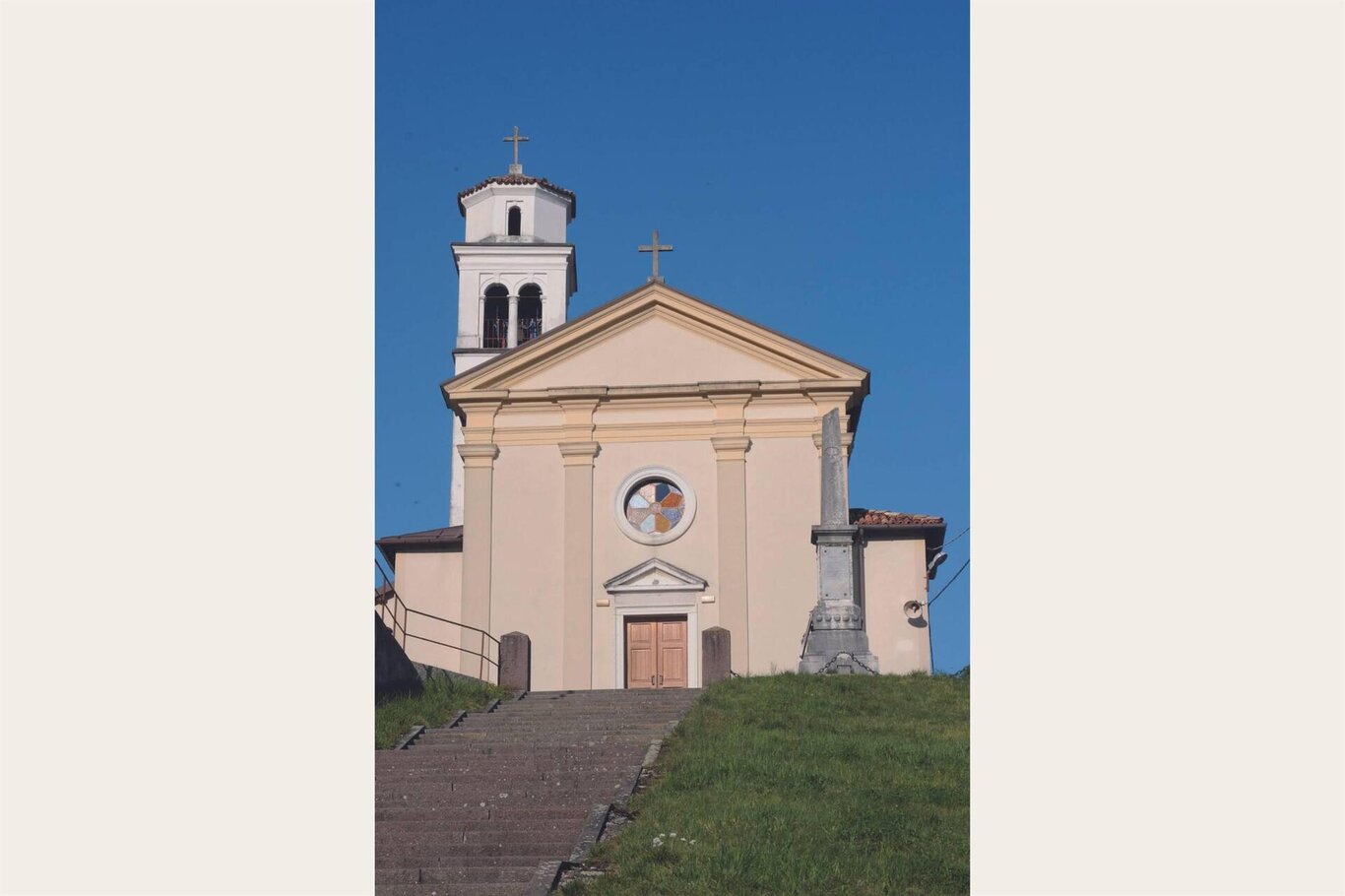The itinerary starts from the sports field of Facen, where you can leave the car, and then head towards the little square, crossed by car just before. In a niche, obtained from the wall of a house, a fresco is visible which represents the Madonna del Rosario with Saints Rocco and Pietro; the votive aedicule was erected by the inhabitants of Facen in 1836, as a thanks for having escaped from the cholera pandemic which struck the Feltre area in those years.
From there take the steep Via Anconetta, finding in a crossroads the Sass del Diaol, a porphyry boulder on whose surface superimposed crosses were engraved in an unspecified period. Continuing west with more moderate slopes, you reach a capital dedicated to the Madonna and the Child, depicted with Saints Vito and Modesto.
There you keep the direction of travel, then leave the paved road at a bend. In fact, you continue along the mule track which in the past was traveled with wooden sledges (musse), to transport loads of hay, wood or foliage down to the valley.
Proceed uphill, on a rather uneven ground, through a wood with a few large black hornbeams, spared from the periodic cuts for the recovery of firewood. In this section you encounter a votive aedicula in an evident state of deterioration, built close to a rocky outcrop, at the junction with a trace of the path that goes up to St. Susanna. A small depression, bordered by a dry stone wall, perhaps represents a source of water collection, to which the devotees attributed particular properties, as was the case for St. Susanna. In fact, this slightly precedes a second aedicula, which is in a poor state of conservation, in which you can see a main niche with two small internal windows and a stone slab roof.
Continue to follow the main road uphill, until reaching a more open and grassy environment, at a crossroads of roads and paths. Your route now enters the paved road, which descends towards the inhabited center of Fiere. For the return, head directly towards the church of Facen, letting yourself be pleasantly distracted by the panorama of the Pre-Alps, Valbelluna, the Alpago mountains and the Dolomites.
Keeping along the main road, there are some examples of typical rural houses and several wooden crucifixes, a sign of widespread popular devotion. The location is called “Venezia Secca”. A little below, it is noticeable some strips of traditional agriculture landscape, where the vine is interspersed with white willows, and the meadows are dotted with fruit trees. On a recently arranged pitch, there is a small fountain fed by a stream and a large washhouse; this place must have been the center of social life for the women of the past, who went there to do the lissia (the laundry).
Continue in the direction of the village, meeting another stone fountain and returning back to the starting point.
FURTHER INFORMATION ON... The landscape we see
It seems incredible that around 200 million years ago, where today there are the Dolomites, there was the sea. Then, due to the progressive rapprochement between the African and Euroasian continents, this sea slowly disappeared. Just as slowly, the layers of sediments, now petrified, were pushed upwards by a few thousand meters and, in some cases, overturned, bent and fractured. The complete emergence, which occurred about 15 million years ago, marked the birth date of the mountains and the beginning of the modeling phase. This territory, affected by several glaciations in the Quaternary, retains only traces of the last one, since each of them has canceled the effects of the previous ones. During the last glaciation, the Piave glacier covered the valley floor up to over 1000 meters in height, leaving the mountain crests and the summit of Mount Avena uncovered. The definitive retreat of the glaciers, which took place about 10,000 years ago, has left us a legacy of rounded shapes such as Mount Aurin, the Croce d’Aune saddle and Valbelluna, with its steep sides. Subsequently the landscape was remodeled by water courses, which dug narrow-bottomed valleys and filled the valley floor with deposits, making it flat.
USEFUL INFORMATION
Start and finish: sports field of Facen (436 m a.s.l.)
Places crossed: Anconetta, Fiere, Venezia Secca, Campolei
Signage: white and blue directional arrows with the words “Anello di Fiere”
Lenght: 3,9 km
Elevation gain: 262 m
Travel time: h 1.00
Difficulty: easy
Recommended period: accessible all year round, but preferably in fall for the colors of the vegetation and in spring for the undergrowth bloom.
Points of interest: Sass del Diaol, votive shrines, villages of Fiere and Venezia Secca, viewpoint of Fiere, wash house of Facen.
Note: short itinerary, easy to follow and with moderate elevation gain, that winds around the village of Facen.
You are in a natural environment that requires respect:
- Prohibition of collecting flowers
- Prohibition of bathing
- No to the shouting
- Prohibition of ignition of fires
- Do not leave waste around, but throw them in the appropriate spaces (also cigarette butts, tissues, masks and wet waste)
- Minors must be accompanied
- Dogs must be kept on a leash and their collected excreta
- Do not leave the path
- Do not disturb the local fauna
It is suggested to inquire through the ARPAV website about any disturbances before embarking on the route.
